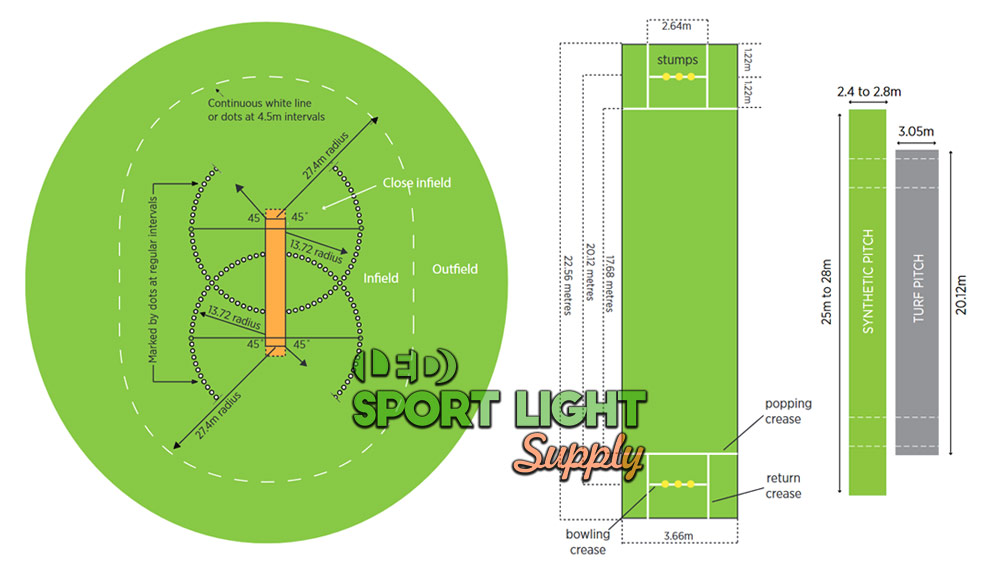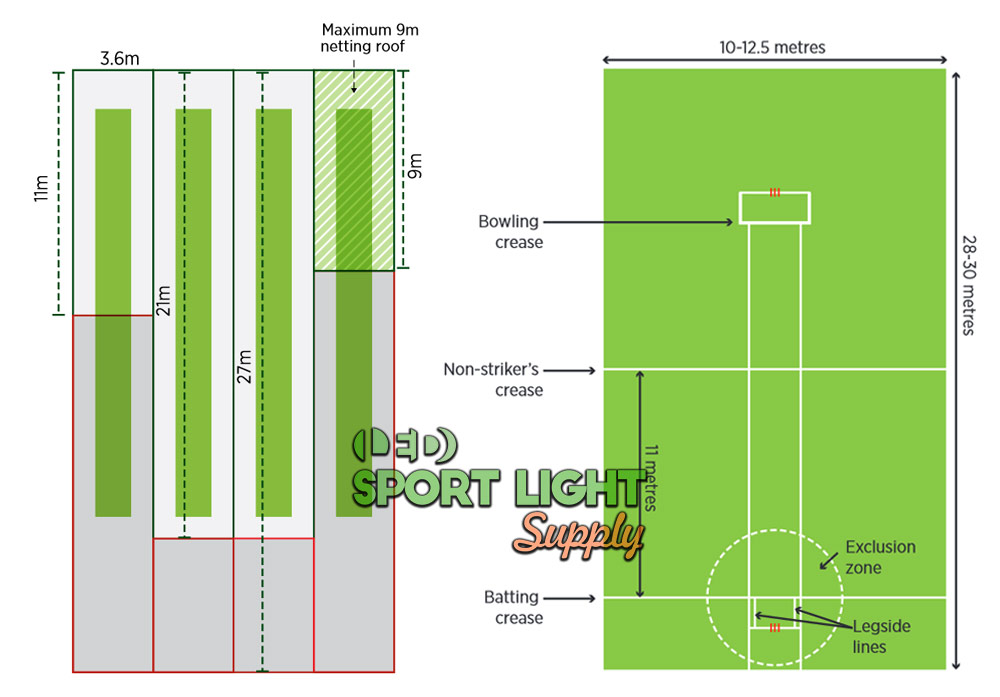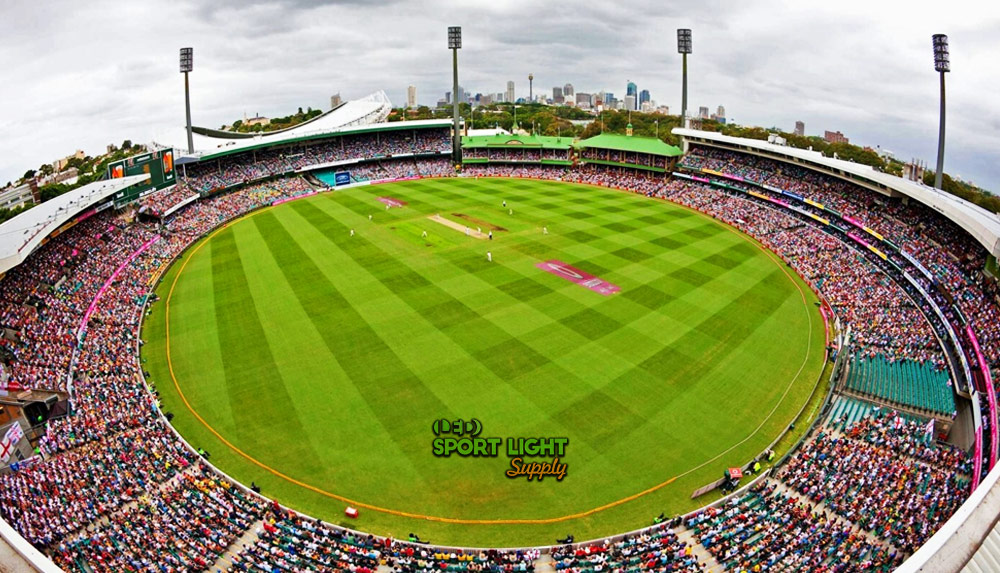Cricket fields can vary in layout, as there are no strict regulations on the size. However, a standard cricket field should feature an oval-shaped outfield and a rectangular pitch, with a curved boundary defining both the closed infield and the infield.
Table of Contents
ToggleCricket Outfield Size

The cricket outfield is typically oval and should have a diameter ranging from 137 to 150 meters (or 450 to 493 feet). To accommodate a cricket ground, a minimum land area of 150 x 150 meters, equating to 22,500 square meters (or 5.5 acres), is required. Additionally, space must be reserved for audience seating and lighting installations. Therefore, a total land area of approximately 6 to 7 acres is generally needed to build a cricket field.
Cricket Infield Size
The infield of a cricket field is shaped like a pill with curved boundaries, featuring a radius of 27.4 meters (90 feet). The center of this circle is positioned at the end of the pitch. The infield area is crucial for gameplay and requires brighter lighting to ensure optimal visibility during matches.
Close-Infield
The close-infield is characterized by two slightly overlapping circles, each with a radius of 13.7 meters (45 feet). This area is important for fielders close to the pitch and requires specific lighting to enhance performance and visibility.
Cricket Pitch Dimension
The pitch is the focal point of the cricket ground, where much of the action occurs. It is a long rectangle measuring 22.56 x 3.66 meters (74 x 12 feet). Ensuring accurate dimensions and proper lighting for the pitch is essential for maintaining the quality of the game.
Cricket Field Size in Acres
To determine the size of a cricket field in acres, we calculate the areas of both the outfield and the pitch.
Outfield Size
The cricket outfield is generally oval-shaped. To approximate its area, we use the formula for the area of a circle, which is π (pi) multiplied by the radius squared. With the diameter of the outfield ranging from 137 to 150 meters (450 to 493 feet), the radius would be half of these measurements. Therefore, the radius is between 68.5 meters and 75 meters.
For a radius of 68.5 meters, the area is calculated by multiplying π (approximately 3.1415) by 68.5 squared. This results in an area of approximately 14,700 square meters, which converts to around 3.6 acres.
For a radius of 75 meters, the area is calculated by multiplying π (approximately 3.1415) by 75 squared. This gives an area of approximately 17,700 square meters, which is about 4.4 acres.
Pitch Size
The cricket pitch is a rectangle with dimensions of 22.56 meters by 3.66 meters. To find the area, you multiply these two dimensions together. This calculation results in an area of approximately 82.6 square meters, which is equivalent to about 0.0204 acres.
Lighting Requirements
Understanding the size of the cricket field is crucial for determining the appropriate lighting requirements. As the size of the field increases, the amount of lumens needed for effective lighting also increases. Larger fields require more powerful lighting to ensure that the entire playing area is uniformly illuminated.
Cricket Ground Dimensions in Feet
To understand the size of a cricket ground in feet, we can perform the calculations using the dimensions provided.
Outfield Size
The cricket outfield is typically oval-shaped. To approximate its area in square feet, we use the formula for the area of a circle: π (pi) multiplied by the radius squared. Given that the diameter of the outfield ranges from 450 to 493 feet, the radius would be half of these measurements. Therefore, the radius is between 225 feet and 246.5 feet.
For a radius of 225 feet, the area is calculated by multiplying π (approximately 3.1415) by 225 squared. This results in an area of approximately 159,000 square feet.
For a radius of 246.5 feet, the area is calculated by multiplying π (approximately 3.1415) by 246.5 squared. This gives an area of approximately 191,000 square feet.
Pitch Size
The cricket pitch is a rectangle with dimensions of 74 feet by 12 feet. To find the area, you multiply these two dimensions together. This calculation results in an area of approximately 888 square feet.
Indoor Practice Cricket Net & Field Size

Practice Cricket Net Size
Indoor practice cricket nets vary in size, but a standard setup is typically 20 meters (66 feet) long and 3.6 meters (12 feet) wide. This results in an area of 72 square meters (775 square feet) for a single net.
If you plan to set up four cricket nets side-by-side, the total width required would be 3.6 meters multiplied by 4, equaling 14.4 meters (47.2 feet). Thus, the total area for four nets would be 20 meters by 14.4 meters, amounting to 288 square meters (3,100 square feet). Larger indoor sports facilities can accommodate more nets if needed.
Indoor Cricket Court Size
In addition to practice nets, indoor cricket courts designed for competitions are also required. Unlike the outdoor oval-shaped fields, indoor cricket courts are rectangular. The length of an indoor cricket court ranges from 28 to 30 meters (92 to 98 feet), and the width ranges from 10 to 12.5 meters (33 to 41 feet). Therefore, you should allocate at least 28 meters by 10 meters, which is 280 square meters (3,000 square feet), to construct an indoor cricket court.
Why Do Cricket Grounds Have Different Sizes?
Different Levels of Competition

The size of a cricket ground often varies depending on the level of competition it is intended for. For recreational play, it is not always necessary to adhere to the full dimensions of an official cricket ground. For example, training facilities might use a smaller field with a reduced diameter.
In contrast, cricket grounds designed for major international tournaments, such as the ICC World Cup, T20 matches, or the Indian Premier League, must meet higher standards. These grounds are typically larger, with an oval-shaped field having a diameter of at least 137 to 150 meters to accommodate the demands of professional play.
Outdoor vs. Indoor
The dimensions of cricket fields also differ between outdoor and indoor settings. Outdoor cricket fields are generally oval and can have a diameter ranging from 137 to 150 meters. This larger size allows for a substantial outfield, which is crucial for accommodating both fielding positions and spectators.
In comparison, indoor cricket courts are rectangular, with typical dimensions of 12.5 by 30 meters. The indoor setup lacks the extensive outfield found in outdoor fields, focusing instead on a more compact area that suits the constraints of indoor spaces.
Land Resources
Land availability can significantly impact the size of cricket grounds. In countries with limited land resources, it may be necessary to construct smaller cricket fields. Additionally, the level of importance placed on cricket within a country influences the size and number of cricket stadiums built. Countries with a strong emphasis on cricket, like India and Australia, are likely to invest in larger and more numerous stadiums compared to countries where cricket is less prominent.
Conclusion
The varying sizes of cricket grounds are influenced by factors such as the level of competition, the type of playing environment, and the availability of land resources. Professional cricket tournaments demand larger, high-standard fields to meet international standards, while recreational and training facilities may opt for more compact dimensions. Indoor cricket courts differ significantly from their outdoor counterparts in both shape and size, reflecting the constraints of indoor spaces. Additionally, land availability and the prominence of cricket in a country play crucial roles in determining the scale and number of cricket grounds.
